Wild paleolithic animals. Hazardous storms. Hostile tribes. These are just a few of the perils you’ll face as your tribe fights for its very survival while trying to create new inventions to advance civilization.
What Is Paleo?
Paleo is a family-friendly cooperative deck and pool-building game for 2-4 players, ages 10 and up, and takes about 45-60 minutes to play. It retails for $59.99 and is currently available to purchase from Amazon or directly from Z-MAN Games.
Paleo was designed by Peter Rustemeyer and published by Hans im Glück and Z-MAN Games, with illustrations by Dominik Mayer.

Paleo Components
Here’s what comes in the box:
- 3 Boards
- 1 Card Cemetery
- 1 Workbench
- 222 Cards
- 40 Wooden Resources
- 48 Tool Tokens
- 40 Wound Tokens
- 5 Skull Tokens
- 5 Victory Tokens
- 2 Custom Dice
Rather than one big board, Paleo uses three smaller boards, which may be arranged on the table in whichever way players find most convenient.

The Base Camp is where you’ll store the tribe’s resources, as well as the various card decks. There’s also an illustration showing what different resources you’re likely to find on different cards.

Event cards will get played or discarded to the Wilderness board. Some other cards can be permanently added at the bottom of the board during a game.

The Night board keeps track of Victory Points and deaths in your tribe. There are also reminders that you must feed each member of your tribe during the Night Phase, as well as meet the requirements of any of the Mission cards, which will be placed at the bottom of the board.
All of the boards are of thick cardboard and evocatively illustrated to suggest the Paleolithic era. There are a couple of other play areas that could have been boards, but instead, the designers chose to create very fun three-dimensional structures, which you assemble from cardboard.

The first of these is the Workbench. When you learn to create a new invention, the card and tokens for that invention are placed directly into slots on one of the two rows. On the base are spaces for the common tools which you know how to craft in every game, as well as illustrations showing the resources required to craft them. These are the basic Resources:
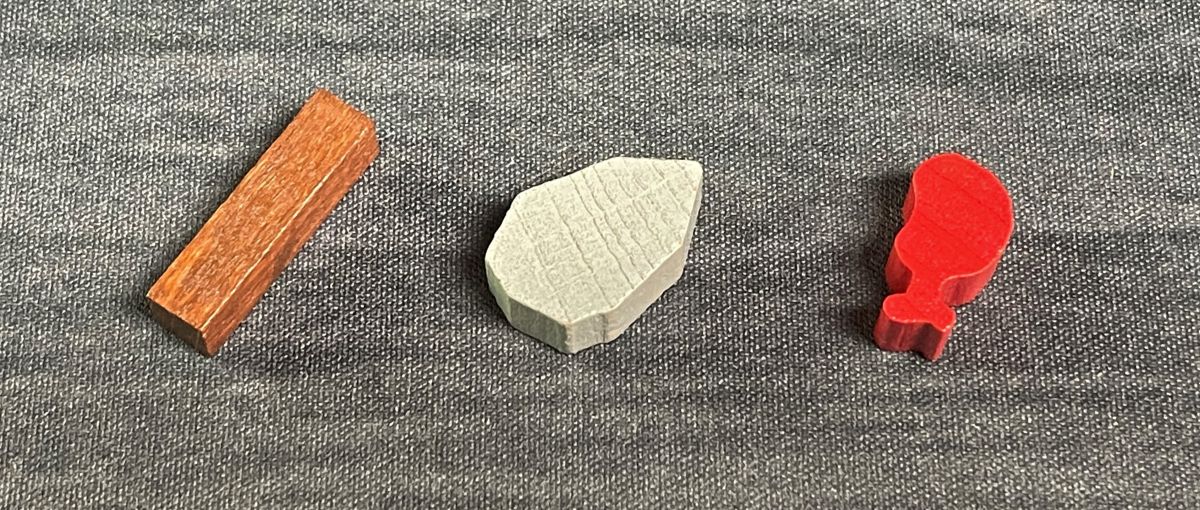
The other 3D structure is the Cemetery. If you’re instructed to remove a card from the game(as denoted by the “X” symbol), it goes into this tray, rather than being returned to the game box as so many other games instruct you to do.
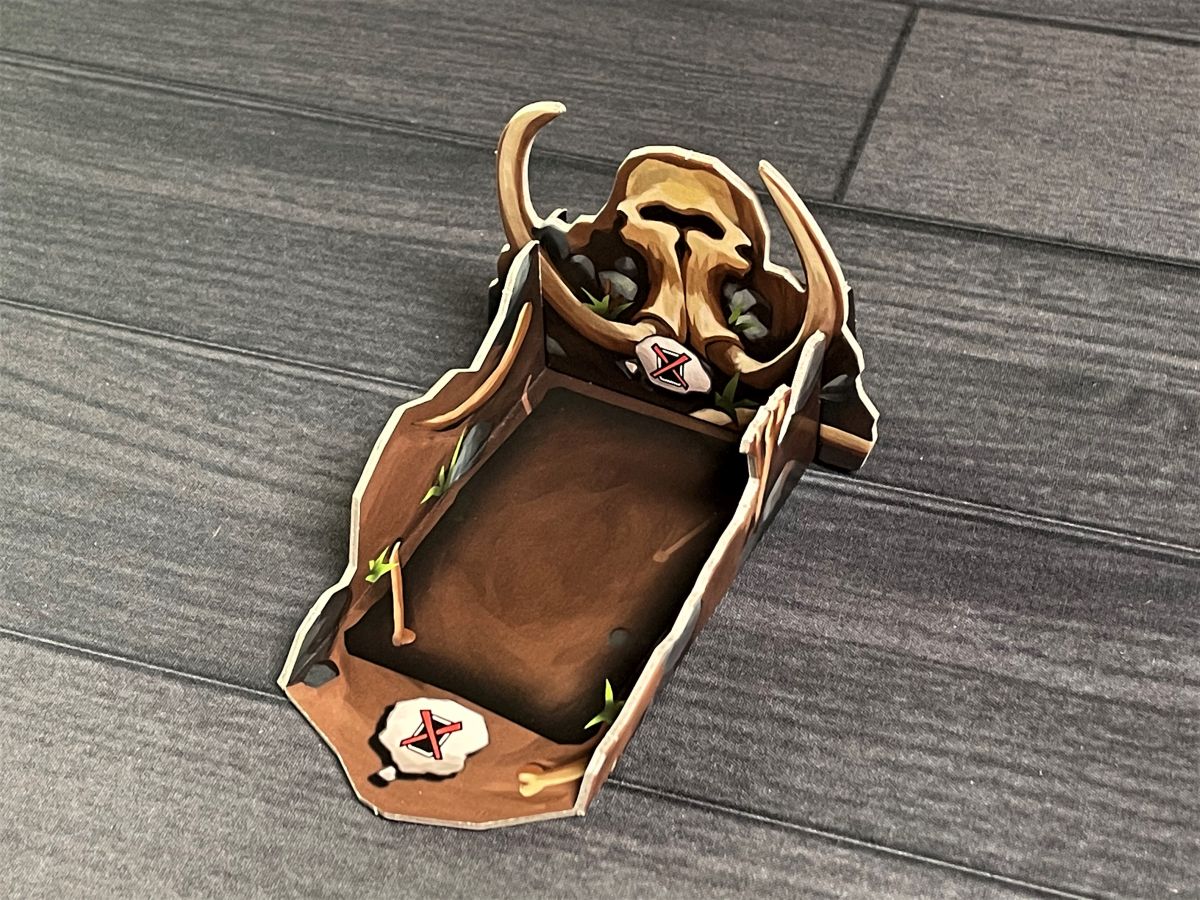
The custom wooden dice have different faces showing ability symbols. Some cards will require you to roll the dice in addition to any other requirements to resolve a card, adding a push your luck aspect to certain actions.

And, of course, there are cards. Lots of different cards. I don’t want to show too many of them as a lot of the experience of playing Paleo is being surprised by the cards that turn up, but here are a few in the official Tabletopia mod, to give you an idea of what they look like:
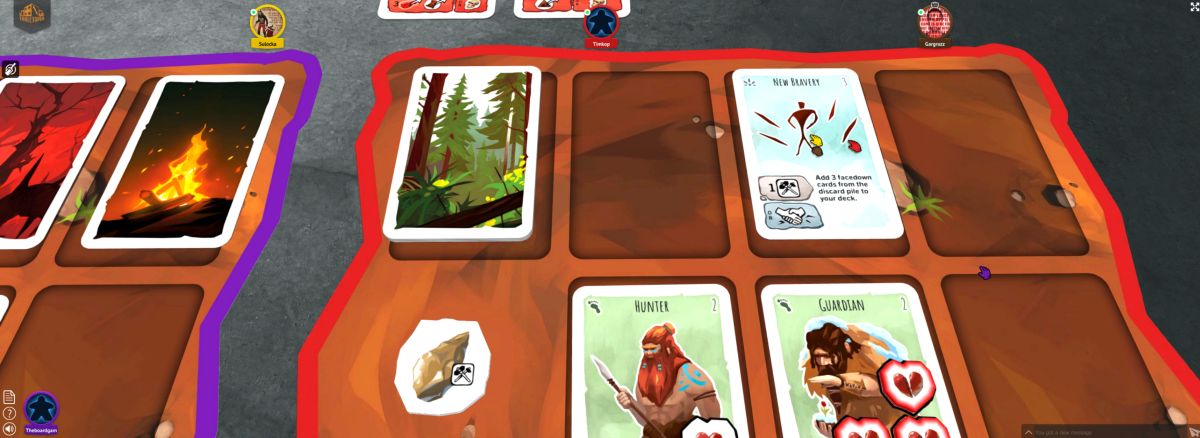
All of the cards are of a good, thick stock, and continue the style of artwork from the boards to create a unified, stylized Stone Age look for the game.

While people have varying opinions on the use of box inserts to sort and store your game pieces, I’m definitely a fan of them when they’re useful. In this case, Paleo has created an organizer that’s not only useful but very thematic, using pictographs in the same style as the game’s artwork to show you what goes where in the box, making for easy cleanup after a gaming session.
How to Play Paleo
You can download a copy of the rulebook here.
The Goal
The goal of Paleo is to work together as a tribe, exploring and inventing, in order to collect the five victory tokens that will complete the cave painting, cementing your tribe’s legacy.
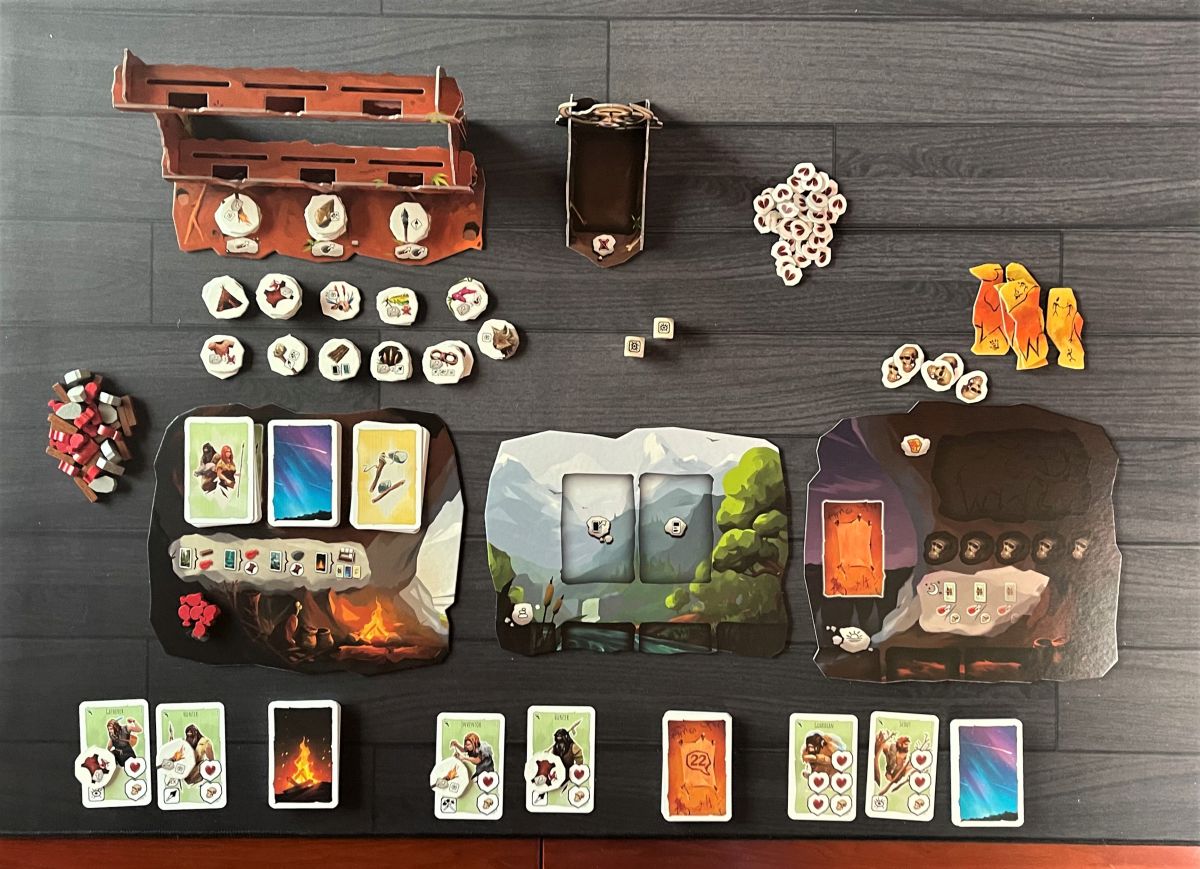
Setup
Start by choosing a level. You will add different cards depending on what level you are playing at.
Place the 3 boards in the middle of the table. Create piles for the Resources and Wound tokens near the boards. Take 5 of the Food and place them onto the Base Camp board. Skull and Victory tokens are placed next to the Night board.
The Workbench is placed near the Base Camp board. Sort the Tool Tokens by type, and place 5 each of the basic Tool Tokens on the base of the Workbench. The remaining Tool Tokens are placed in front of the Workbench. The Cemetery is placed next to the Workbench.

Take the People, Dreams, and Ideas cards, and shuffle each deck separately. Place those 3 decks facedown in their corresponding spaces on the Base Camp board.
Take the Base Card set, add in the modules for the level you are playing at, and remove any cards according to the level’s specific setup instructions. Mission cards will get placed at the bottom of the Night board, while Secret cards will go facedown in a deck on the Night board. Shuffle the remaining cards together, and deal them out to each player as evenly as possible.
Each player draws 2 People from the People deck and places them face-up in front of them, also taking any Tool Tokens that may be shown on those cards.
Gameplay
Paleo is played over multiple rounds, with each round consisting of a Day Phase and a Night Phase.
Day Phase
During this phase, each player takes their turns simultaneously. Everyone draws 3 cards, only looking at the backs of those cards.

Then, each player decides which of those 3 cards they are going to put into play for the round based solely on the card back. The card backs give clues as to what you’re likely to find at that location. For example, a card with a Mountain will often provide stone and/or bearskins. But there also may be a surprise in store, in the form of a bear attack or a rock slide. It’s part of the exploration process that you’re never quite sure what you’ll find the first time you flip a card over. And red cards showing a burning forest are almost always a hazard that you will face.
After choosing one of the facedown cards, the other 2 are returned back to the top of each player’s deck in the order of their choosing. Then everyone flips over their chosen cards at the same time.
Each player chooses 1 option on their card, then resolves it. The players decide as a group what order they resolve the cards. After those cards are resolved, they will either get discarded face-up on the Wilderness board. If there is the symbol of an “X” through a card, that card will instead be moved to the Cemetery.
The Day Phase is repeated until all players have either emptied their decks or decided to discard the rest of their decks to the Wilderness board. At this point, they “go to sleep.”
Resolving Cards
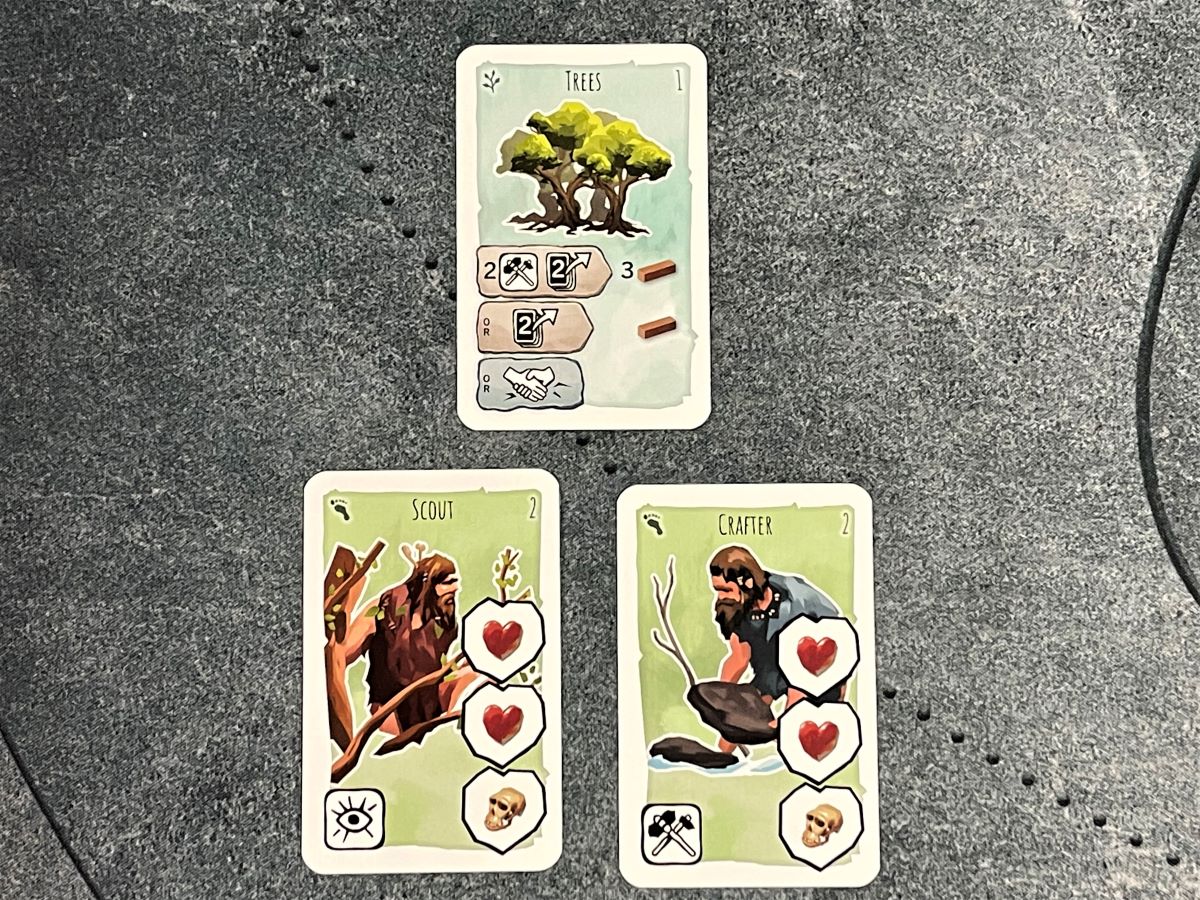
To resolve an Action card, you would choose one of the available actions shown on the card. On the left for each action is the requirement to complete the action, and on the right is the reward. Players can also choose to not resolve an Action card, simply discarding it for no benefit, but no loss either.
In the example above, the player who has the Scout and Crafter has the following choices available to him:
- Have 2 Skill ability and discard the top 2 cards of their deck facedown to the Wilderness board to gain 3 Wood for the tribe. The Crafter innately has 1 Skill ability; the other one needed could be gained either by discarding a Tool Token with the Skill ability symbol or by another player helping who also has a tribe member with the Skill ability. If any of those discarded cards have a red back, one of your People takes a wound!
- Discard the top 2 cards of their deck to the Wilderness board, gaining 1 Wood for the tribe.
- Help another player.
- Discard the card.
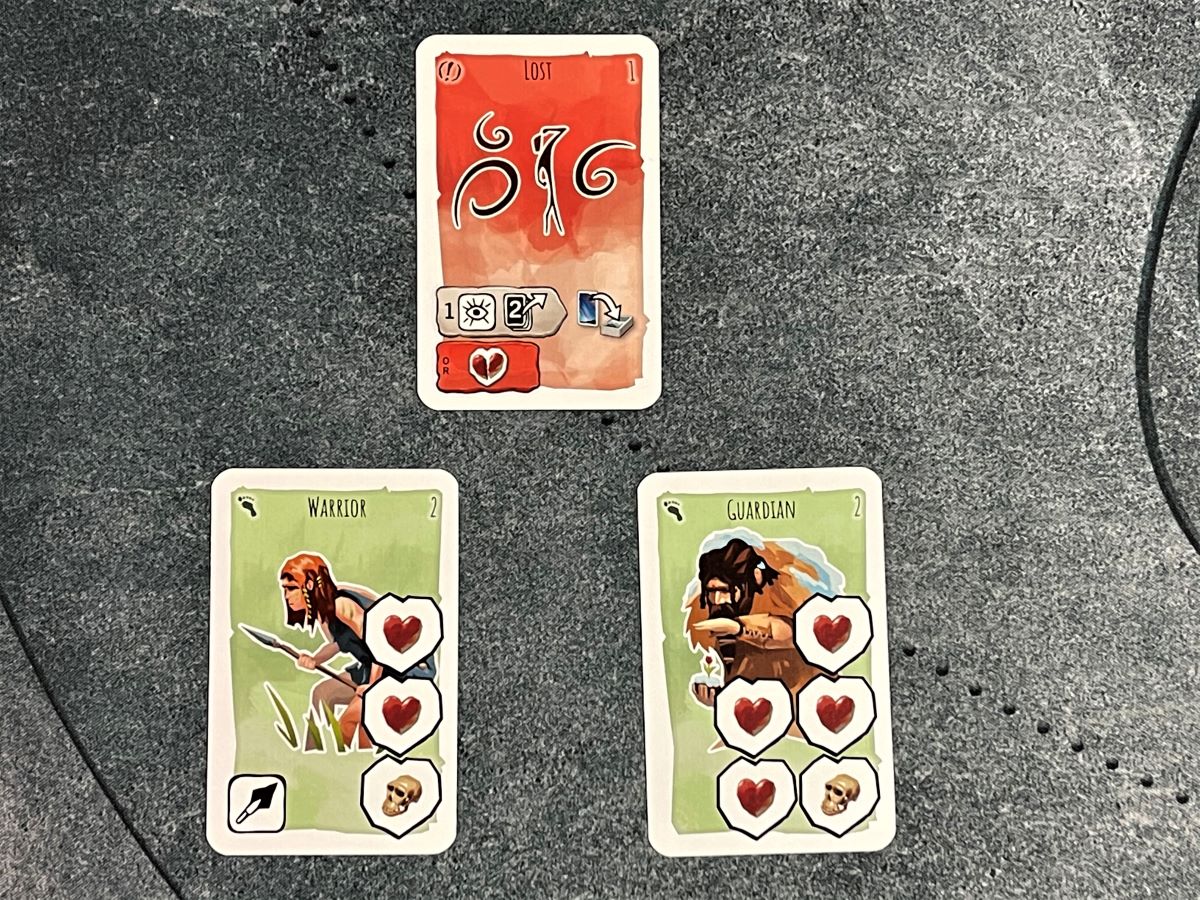
Some cards are Hazard cards, such as the “Lost” card above. Hazard cards must always be resolved. In this example, to resolve the Hazard card, the player must choose one of these 2 options:
- Have 1 Awareness ability and discard the top 2 cards of the player’s deck to draw a card from the Dream deck. As this player’s People in the example above don’t have any innate Awareness ability, they would need to either discard a Tool Token with that symbol or have help from another player to do this option.
- Take a Wound onto one of their People. If the heart spaces are already filled from previous wounds and you’d have to place a wound on the skull space, that person dies and is placed in the Cemetery. A Skull token is then placed on the Night board.


Crafting Action cards, which have the image of a campfire on the back, are resolved like normal Action cards. However, as progressing through the game will require players to do some crafting and inventing, it’s worth showing how to read those cards. In this case, the player would again have three options:
- They may Craft one tool that is available from the Workbench. These may be either the three common tools always available to craft, or an invention that has been added to the Workbench. Note that you must also pay any of the resources shown for the tool from the tribe to craft it.
- If the player has the Skill ability, they can create a new invention. Draw the top card from the Ideas deck, and add that card and its associated Tool Tokens to the Workbench.
- Help another player.
Night Phase
After all players are asleep, the Night Phase begins.
First, pay 1 Food from the supply for each person in the tribe. If there is not enough food to feed everyone, place 1 Skull token for each unfed person on the Night board.

Next, you will have to fulfill the requirements of any Mission cards jointly as a tribe. In the example above, for “Bountiful Prey” the tribe would have to discard 3 Food and 1 Bearskin, or take a Skull onto the Night board.
Finally, if there are any other cards in play that have the Night symbol on them, you would now resolve them the same way you resolved the Mission cards.
Once you have completed the above steps, assuming you were not forced to take a fifth skull, you would then shuffle all of the cards discarded during the last Day Phase together into a new deck, and again evenly deal out the cards facedown to all the players. Then, start a new Day Phase.
Game End

If the tribe has collected all 5 pieces of the cave painting, the players immediately win. These pieces are completed by resolving various actions throughout the game.
If the tribe ever collects all 5 Skull tokens, the players immediately lose.
Paleo is GeekDad Approved!
Why You Should Play Paleo
One of the things that makes Paleo so fun to play is the elegant system of exploration woven into the game. Paleo comes with 10 different modules: these are the different cards that are combined together with the base card set to create the different levels of the game. As I’d mentioned before, the backs of cards give you an idea of what you may find when you flip over a card, but sometimes you’ll be surprised at what you’ll discover. I’d love to give more concrete examples, but I don’t want to spoil any surprises, either…that discovery is part of the joy of the game, where you’re learning about the world around you, and the challenges within.
How you deal with those challenges is the other fun part of the game. Each player will have two People at the start of each game. You’ll have opportunities to add more, and, of course, you may lose People thanks to taking wounds during gameplay. And while all players will select one card to play each round, it’s very rare that every player will be able to resolve each of those cards by themselves in a round. This leads to a lot of discussion amongst the players as to which actions should be taken. After all, not only must you feed all of your tribesmembers by the time night falls, but each level of the game will also have different Missions that must be fulfilled, or else the tribe will take Skulls. Perhaps it was the particular group I was playing with, but I found that Paleo doesn’t seem to lend itself to the kind of quarterbacking that you’ll find in other cooperative games like Pandemic.
You will get a real strong sense of exploration the first few times everyone cycles through their decks. Because many actions require you to discard cards from your deck facedown, you won’t always see all of the cards in play during a particular game. And because the Day Phase always starts with the discarded cards from the previous day being shuffled and dealt back out, you’ll know that some of the cards you have seen, both good and bad, might be popping up again. Like that Mammoth card that will give you a piece of a cave painting when you kill it.

It’s recommended to play the levels in order, like a campaign. While not providing a traditional story like some games, the new modules introduced will provide the tribe with new challenges and events which move the narrative of your tribe forward. The difficulty will also ramp up over the course of the levels, with the final level containing the hardest of the 10 modules. Players are also free to combine the modules any way they like.
No game is entirely free of criticism, and Paleo is no different. There is both a rulebook and a supplement, and when learning the game, you’ll often have to move back and forth between the two, sometimes hunting for a particular rule as there’s no index. And a bit of a pet peeve, but why is the rulebook bound like a book and the supplement is a fold-out?
Another criticism lies in the otherwise delightful artwork. When you look at the different People cards, you’ll find a real lack of diversity. In other words, your tribe is very Caucasian. This is rather unfortunate, and hopefully will be rectified in later editions of the game. Thankfully, your People function more like workers in a worker placement game than characters that you’ll identify with during gameplay. Hopefully, this misstep in the artwork will not turn anyone off from playing an otherwise fantastic game.
Recently, Paleo was nominated for the Kennerspiel des Jahres, a prominent annual board gaming award in Germany, and that comes as no surprise. What Peter Rustemeyer has designed is a compelling cooperative game where the theme is perfectly intertwined with the gameplay. You truly feel like you’re members of a hardscrabble Stone Age tribe, trying to both protect and advance your tribe, but dealing with the many hazards of life in that period.
Click here to see all our tabletop game reviews.
![]() To subscribe to GeekDad’s tabletop gaming coverage, please copy this link and add it to your RSS reader.
To subscribe to GeekDad’s tabletop gaming coverage, please copy this link and add it to your RSS reader.
Disclosure: GeekDad received a copy of this game for review purposes.
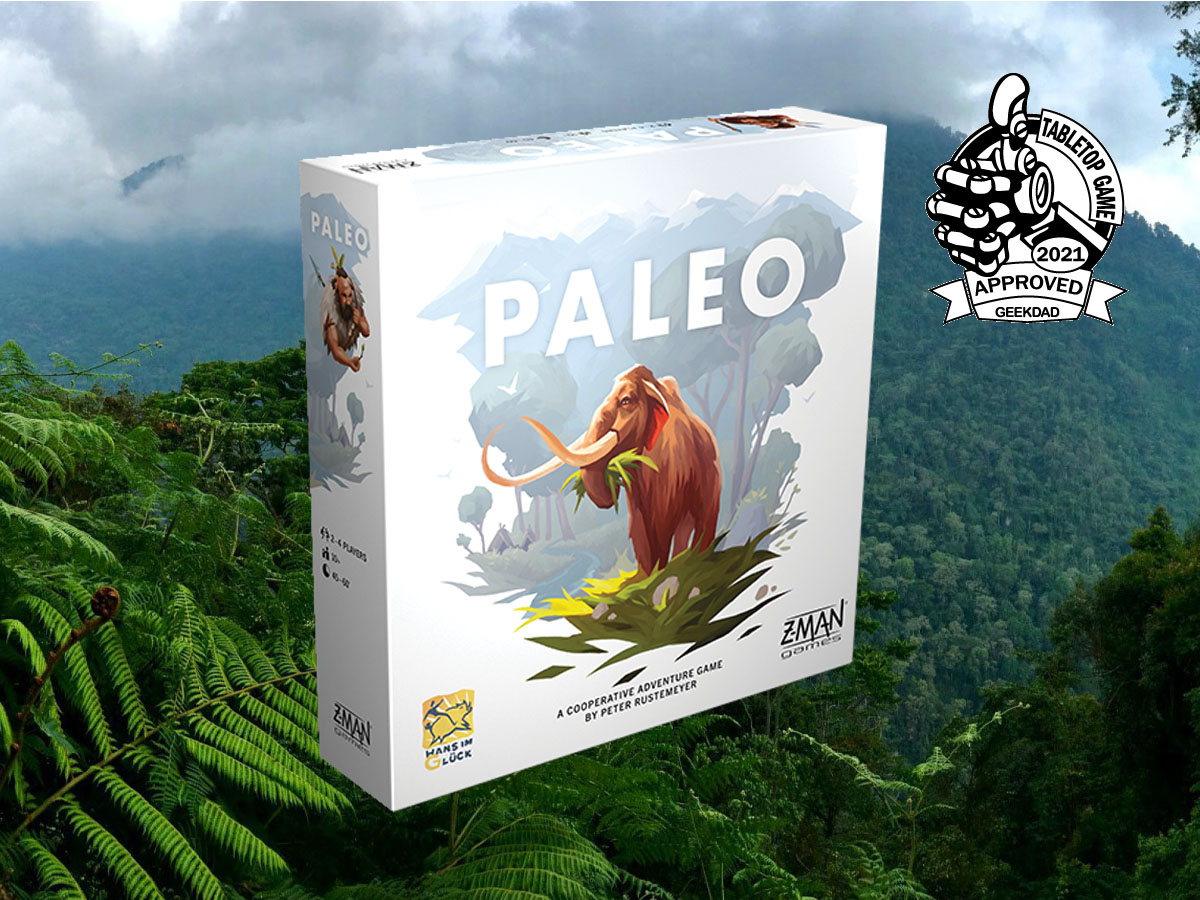



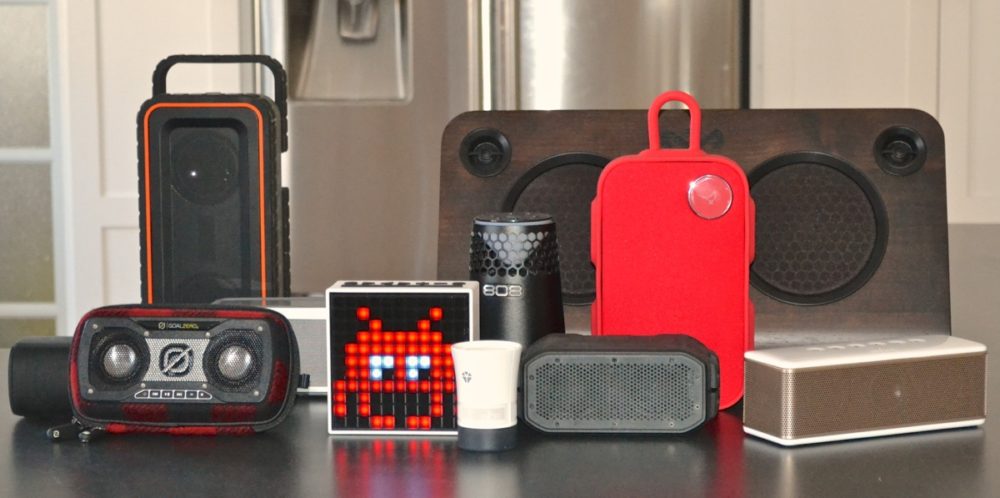

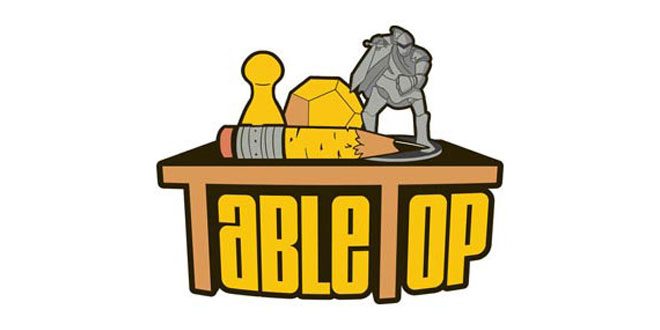
Thank you for the excellent, clear review. Holy smokes that looks fun. The nighttime element sounds a bit like the party game Wolves & Villagers, except that in this, the participants are all villagers.
And thank you for the compliment! If you wanted to give it a try before you get your own copy, they have a very nice official port of the game on Tabletopia.